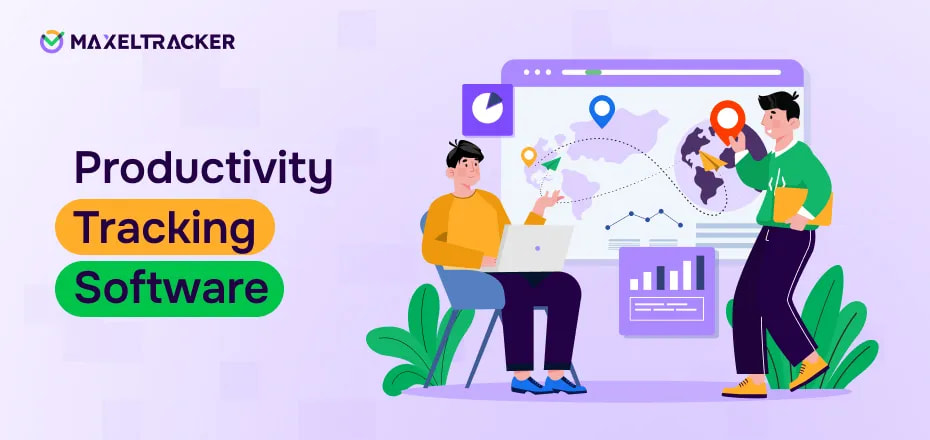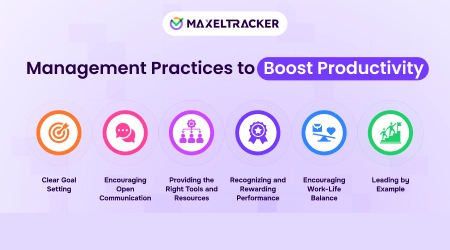

Productivity is more than just a metric—it’s a reflection of how efficiently teams work, collaborate, and deliver results. As organizations grow and adopt diverse work models, keeping track of how time and resources are used becomes increasingly important. Productivity tracking software offers a practical solution, helping businesses understand work patterns, reduce inefficiencies, and support better decision-making.
This guide explores what productivity tracking software is, why it matters for both managers and teams, and how it can be implemented effectively to drive measurable improvements across the workplace.
Productivity tracking software is a tool designed to monitor how time and effort are spent across tasks and projects. It helps individuals and teams keep a clear record of activities, track the completion of tasks, and measure the time invested in each one. For organizations, it also serves as a way to observe employee productivity patterns.
Employee Productivity tracking software often generates detailed reports that highlight trends, reveal inefficiencies, and offer insights into where improvements can be made. Whether used for time management, project oversight, or improving team performance, productivity tracking software plays a key role in helping people stay focused, organized, and consistent in their work.
Productivity tracking records key data about how employees manage their time, activities, and tasks during the workday. This data provides valuable insights into their performance, engagement, and efficiency. Here's what productivity tracking typically records:
Time Usage: Logs time spent on specific tasks, projects, clients, etc., offering breakdowns of where time is being spent. This helps identify areas that require attention or more focus.
Computer Activity: Tracks apps, websites, and documents used on work devices, measuring active time spent in different applications and tasks to evaluate productivity with Live screen monitoring software.
Idle Time: Records periods of inactivity or breaks during work hours, providing insight into when employees are not actively engaged or are taking a break while clocked in.
App Usage: For employees working remotely or in the office, time spent in different work-related apps is tracked, ensuring a complete view of their activity across devices.
Tasks Completed: Integrates with systems like project management tools to track the number of tasks or milestones completed, helping to assess individual and team progress.
Attendance Tracking: Tracks clock-in and clock-out times, breaks taken, and monitors early or late arrivals, ensuring that employees adhere to their working hours and schedules.
Location Tracking: For remote team, employee location tracking can confirm attendance and verify that employees are working from their designated areas, if needed.
Screenshots: Captures periodic screenshots to provide visual evidence of the employee's activity, allowing managers to monitor work in real-time without disrupting the flow.
Work Patterns and Trends: Identifies patterns such as peak productivity hours, moments of inactivity, and trends in task completion. Understanding these patterns can guide schedule adjustments and workload distribution.
Employee tracking offers valuable insights that help companies manage their workforce more effectively, improve productivity, and maintain a well-structured work environment. By monitoring how time is spent, tracking progress on tasks, and identifying areas for improvement, businesses can make informed decisions, support employee development, and ensure smoother day-to-day operations. When used transparently, it promotes accountability, fairness, and stronger team performance. Here's a deeper look at how a company can benefit from employee productivity tracking:
Employee tracking tools help managers stay on top of project progress by recording time spent on different tasks and activities. This allows for better planning and resource allocation. When employees log their hours and activities, managers can easily identify any delays or obstacles and take corrective action immediately. Whether it’s adjusting deadlines, redistributing tasks, or offering additional support, tracking ensures that projects stay on track. It enables managers to anticipate issues and make informed decisions to improve the overall efficiency and outcome of projects. By knowing which employees are dedicating time to what projects, managers can adjust workloads based on availability, skill set, or urgency, leading to smoother project execution and more predictable outcomes.
Tracking employee activity enables companies to identify areas where time is being wasted and streamline work processes. When employees’ activities are logged, it becomes easy to see where distractions, delays, or inefficiencies are occurring. For example, if certain software or websites are being overused during work hours, adjustments can be made to ensure that employees focus on tasks that contribute to their productivity. Additionally, data from tracking tools can reveal which employees are performing tasks efficiently, helping companies share best practices across teams. With clear data on employee performance, organizations can identify time-consuming bottlenecks and implement solutions, whether it’s adjusting work processes, providing training, or changing resource allocation, ultimately improving overall operational efficiency.
Employee tracking doesn’t only monitor output—it can also encourage and motivate employees when done transparently. Tracking helps establish clear expectations and accountability, showing employees where their time and effort go. With data-driven feedback, employees can clearly see how their work impacts the company, leading to a sense of accomplishment. Recognition for good performance becomes more objective, and employees are more likely to feel that their efforts are valued. Additionally, tracking can highlight areas where employees need support, which can lead to targeted training and professional development, fostering personal growth and job satisfaction. When employees know they are being fairly evaluated based on real data, it builds trust between them and management. It can reduce anxiety about performance reviews and boost overall job satisfaction as employees see their contributions acknowledged in a tangible way.
Employee evaluations often rely on subjective judgments, but productivity tracking provides an objective basis for assessment. Managers can use data from tracking tools to review an employee’s performance, providing concrete examples of how time was spent and whether targets were met. Instead of relying on gut feelings or anecdotal evidence, evaluations can be based on actual productivity metrics, such as the number of tasks completed, the quality of work, or time spent on specific activities. This makes performance reviews more accurate, fair, and transparent. With consistent tracking, evaluations are not limited to periodic reviews but can be done in real-time, allowing managers to provide ongoing feedback and guidance. This continuous feedback loop helps employees understand how they can improve, making the evaluation process more dynamic and useful for career development.
Employee tracking offers managers greater visibility into day-to-day operations, giving them more control over workflows, resources, and employee performance. By tracking metrics such as time spent on tasks, attendance, and task completion, managers can make informed decisions quickly. This allows for proactive intervention if there’s a dip in performance or an employee is struggling with time management. Whether it’s adjusting work schedules, shifting resources to more urgent tasks, or providing training to improve skills, tracking data gives managers the insight they need to take decisive action. This greater control also extends to ensuring that work goals are aligned with organizational priorities. Managers can use tracking data to prioritize work based on business needs, ensuring that the most important tasks are completed first and that employees are contributing to high-priority objectives.
MaxelTracker gives businesses a clear picture of how employees use their work hours, whether they’re working remotely or from the office. By automatically tracking time, app and website usage, idle periods, and more, it provides real-time data that helps managers identify productivity patterns, reduce time wastage, and improve team performance. With these insights, companies can make informed decisions, support employees better, and keep projects on track.
MaxelTracker captures time spent on various tasks without the need for manual input. Once employees begin their work, the software logs start and end times, tracks task switches, and records activity duration automatically. This removes guesswork and provides accurate, up-to-date records that managers can rely on for workload planning and billing.
The software uses intelligent categorization to label apps and websites as productive, unproductive, or neutral based on the employee’s role. These benchmarks allow teams to assess how effectively time is being used, compare performance across departments, and set clear productivity standards. It helps companies measure outcomes, not just hours worked.
MaxelTracker detects periods when there’s no mouse or keyboard activity, flagging them as idle time. This gives context to time logs—helping managers distinguish between focused work sessions, legitimate breaks, and potential distractions. It also aids in creating more balanced schedules by identifying signs of burnout or disengagement.
With distributed teams becoming common, MaxelTracker ensures that remote work doesn’t compromise visibility. Remote Employee Monitoring feature tracks work hours, app usage, activity levels, and attendance, so managers can understand how remote employees are contributing. It builds trust and transparency without micromanagement.
MaxelTracker provides detailed logs of the applications and websites accessed during work hours. This helps employers see which tools are being used productively, which ones might be slowing down work, and whether there are unnecessary distractions. Over time, this data supports better software investments and training decisions.
MaxelTracker’s reporting system does more than track activity—it translates data into meaningful insights that help organizations measure, evaluate, and enhance employee productivity. Here’s a deeper look at how each report type contributes:
MaxelTracker provides a comprehensive breakdown of how employees allocate their time throughout the day. These reports detail how much time is spent on specific tasks, projects, applications, or websites. Managers can clearly see which activities consume the most time, whether those are aligned with job priorities, and where inefficiencies might exist. For instance, if an employee spends a large portion of the day on email rather than on client work or deliverables, it could signal the need for workflow changes. By having a transparent view of time allocation, teams can better manage workloads and reduce time lost on low-value tasks.
Using role-specific benchmarks, MaxelTracker generates a productivity percentage for each employee or team. These scores are based on how much time is spent on activities classified as productive, unproductive, or neutral. For example, a graphic designer using tools like Adobe Photoshop and Illustrator will score higher if their time is focused on those apps, compared to spending hours on social media or messaging tools. These scores give managers a fast, data-backed way to assess performance, identify trends, and recognize employees who consistently maintain high productivity. It also helps set realistic productivity goals tailored to specific job functions.
Reports on idle and active time reveal how often employees are engaged in actual work versus being inactive while logged in. Idle time is recorded when there's no keyboard or mouse activity for a certain period. While occasional breaks are healthy, frequent or extended idle periods may indicate a lack of engagement, distractions, unclear expectations, or workload imbalance. On the other hand, consistently high active time can point to strong focus or, in some cases, overwork. These insights help HR and team leads address concerns early, whether it’s by adjusting assignments, providing support, or promoting better time management habits.
MaxelTracker tracks every application and website accessed during work hours and categorizes them based on relevance to the employee’s role. These usage reports offer valuable insight into digital habits, highlighting which tools are used most, whether they're appropriate for work, and where time might be wasted. For example, if a marketing team member spends most of their day on design and analytics tools, that suggests alignment with their responsibilities. But regular visits to unrelated entertainment sites may need to be addressed. These reports are also useful when evaluating which tools help improve productivity and which ones may need to be replaced or restricted.
By viewing productivity data across different time frames, companies can identify long-term patterns and fluctuations. Daily trends might reveal common distractions or peak productivity hours, while weekly or monthly trends can help evaluate performance stability and consistency. For example, a noticeable decline in output every Friday could suggest fatigue at the end of the week, while a steady drop over months may signal burnout or poor engagement. These trends are also useful for measuring the effectiveness of operational changes, such as introducing new tools, shifting work schedules, or revising team structures.
MaxelTracker’s reports allow businesses to compare productivity data across various departments, teams, or job roles. This makes it easier to understand where performance is thriving and where extra support might be needed. For instance, a sales team that’s underperforming compared to others might benefit from additional training or improved lead management tools. These comparisons ensure that expectations remain fair across different job types, highlight successful strategies from top-performing teams, and encourage a culture of continuous improvement. They also help HR teams make more informed staffing, training, and resource allocation decisions.
Productivity tracking with MaxelTracker gives businesses precise, data-backed visibility into how work hours are used, activity levels, and overall output. Its core features—automated time logging, idle time monitoring, and customizable reports—turn raw data into clear metrics for improving productivity. Managers gain deep insights into team performance, enabling smarter resource allocation and more effective support.
MaxelTracker’s flexible tracking adapts to your unique workflow, delivering measurable gains in output and profitability. Move beyond guesswork and let real data guide your decisions. Get started with MaxelTracker today to take control of time and work. 👉 Sign up now at MaxelTracker.com and start transforming your team’s productivity today! 🚀
👉 Explore our pricing plans and features to find the perfect solution for your team’s productivity needs! 🚀
Related Blogs

Employee Productivity Dashboard Every Organization Needs
Managing today’s teams means juggling moving deadlines, hybrid work setups, and higher-than-ever expectations. When updates are scattered across different tools or passed along secondhand, it slows everyone down and puts project success at risk.

How to Track Productivity of an Employee Working from Home?
Remote work is no longer a trend—it's the new norm. Businesses now need clear, efficient ways to track productivity without micromanaging. When employees work from home, traditional supervision is gone.

Top Management Practices That Can Improve Employee Productivity
Strong management drives workplace efficiency. Employees perform better when leaders provide structure, support, and clear expectations. Without effective management, teams struggle with miscommunication, low motivation, and wasted time.